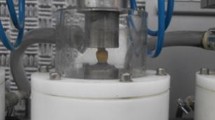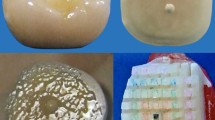Abstract.
Background: During orthodontic treatment with a multiband appliance, enamel decalcifications and periodontal irritation may occur due to inevitable plaque retention. Besides the band itself, non-cemented gaps between tooth and band constitute a problem that has not yet been investigated from quantitative aspects.
Materials and Methods: In this in vitro study, the cement distribution beneath the orthodontic band was investigated on 48 identical transparent resin replicas of upper molars and lower molars, respectively. The replicas with the cemented orthodontic bands were divided into buccal, distal, oral, and mesial segments so that the inner surfaces of the bands could undergo morphometric analysis for areas not covered with cement. Two different molar bands (Dentaform® Snap by Dentaurum, Ispringen, Germany, and "Washbon" by Ormco, Orange, CA, USA), and two glass-ionomer cements (OptiBand™ by Ormco and Ultra Band-Lok Blue by GAC, Gräfelfing, Germany) were used. In this way, 8 test series with twelve specimens each were performed.
Results: Not one cement-band combination was without defects in the cement film, with poorer cement flow properties being observed at the upper than at the lower molars. In general, fewer defects were recorded in the occlusal than in the cervical areas. Overall, the buccal surfaces yielded the best results, and the mesial surfaces the poorest.
Conclusions: Since defects in the cement film have so far been unavoidable, the indication for orthodontic treatment with a multiband appliance must continue to be strict. Unless accompanying professional prophylactic care coupled with optimal oral hygiene is ensured, multiband appliances should be used with great caution.
Zusammenfassung.
Hintergrund: Bei kieferorthopädischer Bebänderung von Zähnen kann es durch die zwangsläufig entstehenden Retentionsnischen zu Entkalkungen der Zähne und zur Irritation des Parodonts kommen. Abgesehen vom Band selbst sind nicht mit Zement ausgefüllte Spalten zwischen Band und Zahn ein Problem, das bisher noch nicht quantitativ untersucht worden ist.
Material und Methoden: In dieser In-vitro-Studie wurde an 48 identischen Repliken von Oberkiefermolaren und 48 identischen Repliken von Unterkiefermolaren aus durchsichtigem Kunststoff die Zementverteilung unter dem kieferorthopädischen Band untersucht. Die Zahnrepliken mit zementiertem Band wurden in bukkale, distale, orale und mesiale Segmente aufgetrennt, sodass die Innenseiten der Bänder auf nicht von Zement bedeckte Areale hin morphometrisch untersucht werden konnten. Zur Untersuchung kamen zwei verschiedene Molarenbänder (Dentaform® "Snap" von Dentaurum, Ispringen, Deutschland, und "Washbon" von Ormco, Orange, CA, USA) und zwei Glasionomerzemente (OptiBand™ von Ormco und Ultra Band-Lok "Blue" von GAC, Gräfelfing, Deutschland). Auf diese Weise wurden acht Testreihen zu je zwölf Zahnproben durchgeführt.
Ergebnisse: Keine einzige Zement-Band-Kombination war ohne Fehlstellen im Zementfilm, wobei an den Oberkieferzähnen ein schlechteres Ausfließverhalten des Zementes als an den Unterkieferzähnen beobachtet wurde. Generell zeigten sich im okklusalen Bereich weniger Fehlstellen als im zervikalen. Die bukkalen Flächen flossen insgesamt besser aus, die mesialen am schlechtesten.
Schlussfolgerungen: Weil sich Fehlstellen in Zementfilm bisher nicht vermeiden lassen, muss die Indikation für kieferorthopädische Bebänderung weiterhin streng gestellt werden. Ohne begleitende professionelle Prophylaxe bei maximaler Mundhygiene sollte man mit einer kieferorthopädischen Bebänderung sehr zurückhaltend sein.
Similar content being viewed by others

Author information
Authors and Affiliations
Corresponding author
Rights and permissions
About this article
Cite this article
Radlanski, R.J., Renz, H. & Reulen, A. Distribution of the Cement Film Beneath the Orthodontic Band: a Morphometric In Vitro Study. J Orofac Orthop 64, 284–292 (2003). https://doi.org/10.1007/s00056-003-0311-x
Received:
Accepted:
Issue Date:
DOI: https://doi.org/10.1007/s00056-003-0311-x



